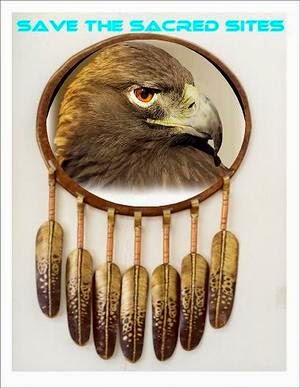HELP MY LOCAL UTAH TRIBES SAVE A 3,000 YEAR OLD SACRED SITE
Body:
Hello Everyone! I know it has been awhile since I have asked for help. I am staying at my parent's house and have internet now but no phone. Please read the story below and email our Lt Governor or call to tell them not to build a train station on a site that has been holy to the 6 indigenous Utah Native American Tribes for over 3,000 years.
Peace and Love~
Cola
http://www.utah.gov/ltgovernor/contact.html
Utah State Capitol Complex
P.O. Box 142325
Salt Lake City, Utah 84114-2325
800-995-VOTE
800-705-2464
Fax 801-538-1133
Tribes ask governor to thwart train station on archaeological site
Draper » Legislature OK'd trade of state lands for FrontRunner station.
By Brandon Loomis
The Salt Lake Tribune
Updated: 07/23/2009 06:56:04 AM MDT
Curtis Cesspooch, chairman of the Uintah/Ouray Utes, speaks at a press conference Wednesday opposing the use of an ancient American Indian site in Draper for a FrontRunner train station. (Anna Kartashova/The Salt Lake Tribune)Seven Utah tribes joined Wednesday in petitioning lawmakers and Utah's next governor to protect the site of an ancient village where the Utah Transit Authority has proposed building a train station.
In a rare public show of unity, statewide tribal leaders converged on Salt Lake City for a news conference releasing a joint resolution asking Lt. Gov. Gary Herbert to save the so-called Galena property in Draper. Herbert will become governor if the U.S. Senate confirms Gov. Jon Huntsman Jr. ambassador to China.
"Are we so insignificant that we are overlooked and desecration is done to our sites?" said Curtis Cesspooch, chairman of the Uintah/Ouray Utes.
UTA wants to build a FrontRunner commuter rail station on one of four sites including the Draper property, which is on a bluff east of the Jordan River around 13500 South. The 230-acre parcel on which a station and associated development would perch contains what the state archaeologist has declared significant American Indian sites dating to 3,000 years ago.
Initial investigations yielded hints at the earliest known corn farming in the Great Basin.
The Utah Legislature mandated the land's preservation for open space and other resources in 2000, but the Department of Natural Resources never signed a proposed perpetual conservation easement and last winter lawmakers reversed course to accommodate UTA's proposal. DNR Executive Director Mike Styler acknowledged delaying action on the conservation easement last year at then-House Speaker Greg Curtis' request. Curtis is an attorney who also represented a potential purchaser for the land, though his client later backed out.
Now the DNR is authorized, but not mandated, to trade the property with an adjacent private owner and allow the station. UTA originally listed the Draper site as its top pick, but on Wednesday spokesman Gerry Carpenter said the agency is open to discussions.
"We're a little surprised that this press conference took place because we have reached out to the tribes," Carpenter said. "We haven't decided anything."
Tribal leaders said Herbert asked them to hold off until he could organize a meeting between all interested parties, but they decided it was too important to wait.
"Utah has always respected our heritage," said Rupert Steele, chairman of the Confederated Goshutes. "This site is considered sacred ground to Native Americans."
"We're going to be destroying a lot of history," said Paiute Chairwoman Jeanine Borchardt, "and this history is the history of Utah."
Leaders of the Utah Navajo, Northwestern Band of Shoshone, Ute Mountain Ute and Skull Valley Goshute tribes also signed the resolution
asking Herbert to save the property. The tribes ask that Herbert sign a conservation easement protecting the land.
Herbert had not seen the tribes' resolution on Wednesday and was unprepared to comment, spokeswoman Angie Welling said. He will follow up with a meeting, though, she said.
"The lieutenant governor has indeed expressed to tribal leaders his desire to bring all the stakeholders together to come up with a workable solution on this issue," Welling said in an e-mail. "He certainly has no desire to see the disruption of culturally significant archaeological items and intends to bring together all interested parties soon."
The tribes also complained of conflicts of interest on the UTA board. Board member Terry Diehl and former member Greg Simonsen disclosed conflicts and said they would recuse themselves from the property discussions. Diehl worked as a consultant for a company that sought to purchase and develop the property around the station, and Simonsen was attorney for the bankrupt company seeking to sell it.
Simonsen, who resigned from the board this summer after surviving a heart attack, said Wednesday that he would not have made a commission on the property. Diehl declined to comment.
Subscribe to:
Post Comments (Atom)






No comments:
Post a Comment
Note: Only a member of this blog may post a comment.